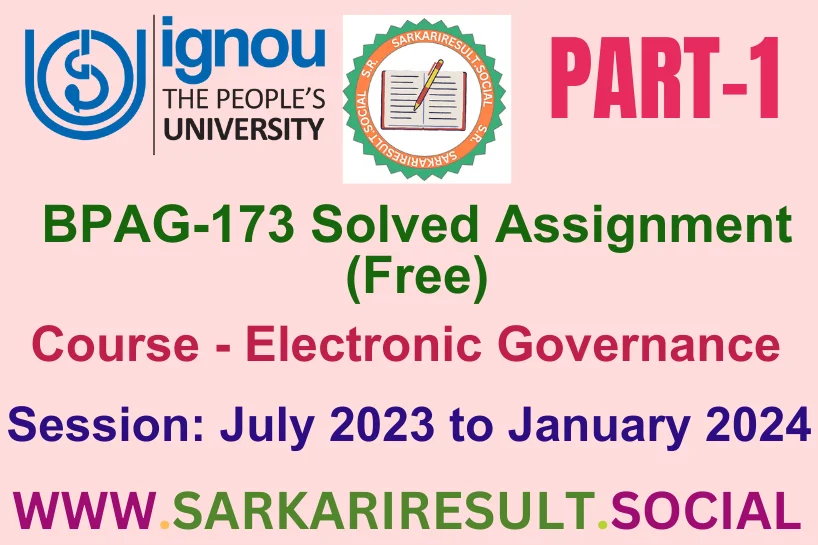BPAG 173 SOLVED IGNOU ASSIGNMENT FREE PART 1

Welcome to the BPAG 173 SOLVED IGNOU ASSIGNMENT FREE PART 1 TMA. Assignment B streamlines your approach with concise answers to three pivotal questions. In about 250 words each, explore the components and types of information systems, highlight the features of the National Policy on Electronics 2019, and discuss the role of Information and Communication Technology applications in rural development. Our short and focused responses provide a straightforward path for grasping these critical aspects of electronic governance, ensuring a smooth and successful completion of your assignments.

Answer the following questions in about 500 words each.
Q.1 Discuss the concept and models of e-governance.
Ans. E-Governance, or electronic governance, is the utilization of information and communication technologies (ICTs) to enhance the efficiency, transparency, and effectiveness of government services and processes. It involves the integration of technology into the administrative and decision-making functions of government to improve service delivery, engage citizens, and streamline internal operations. Here, we discuss the concept and various models of e-governance:
1. Concept of E-Governance:
– E-Governance represents a paradigm shift from traditional governance to a more technologically advanced and citizen-centric approach.
– It leverages ICT tools to facilitate seamless interaction between government and citizens, businesses, and other stakeholders.
– The primary goals include improved service delivery, increased transparency, enhanced citizen participation, and efficient decision-making.
2. Models of E-Governance:
a. G2C (Government-to-Citizen):
– Description: In this model, government services are directly provided to citizens through digital platforms.
– Examples: Online tax filing, utility bill payments, and citizen portals for accessing various services.
b. G2B (Government-to-Business):
– Description: In this model, government interacts with businesses and industries electronically, simplifying regulatory processes and promoting ease of doing business.
– Examples: Online business registration, e-procurement systems, and digital licensing.
c. G2G (Government-to-Government):
– Description: This model involves electronic interaction and information exchange between different government departments and agencies.
– Examples: Government intranets, data sharing platforms, and integrated information systems.
d. G2E (Government-to-Employee):
– Description: E-Governance serves internal government processes, improving communication and HR functions for government employees.
– Examples: Online leave management systems, employee portals, and digital training platforms.
e. C2G (Citizen-to-Government):
– Description: This model emphasizes citizen engagement and participation in governance through digital platforms.
– Examples: Online petitions, participatory budgeting, and feedback mechanisms on government policies.
f. M-Governance (Mobile Governance):
– Description: With the widespread use of mobile devices, m-governance focuses on delivering government services through mobile applications.
– Examples: Mobile-based payment systems, information dissemination, and service alerts.
g. Social Media Governance:
– Description: Social media platforms are utilized for communication, engagement, and dissemination of information.
– Examples: Government announcements on platforms like Twitter and Facebook, citizen forums for discussion.
3. Benefits of E-Governance:
– Efficiency: Streamlining administrative processes reduces bureaucratic delays and enhances service delivery.
– Transparency: Digital platforms promote openness, making government activities and decisions more visible to the public.
– Citizen Empowerment: E-Governance facilitates citizen participation, allowing them to access information and contribute to decision-making.
– Cost-Effectiveness: Automation of processes can lead to cost savings for both the government and citizens.
– Data Security: Robust information security measures protect sensitive data and ensure privacy.
4. Challenges of E-Governance:
– Digital Divide: Unequal access to technology and the internet can exclude certain segments of the population.
– Cybersecurity Risks: E-Governance systems are susceptible to cyber threats, requiring robust security measures.
– Resistance to Change: Administrative cultures may resist the shift to digital processes, hindering implementation.
– Infrastructure Limitations: Inadequate ICT infrastructure can impede the effective deployment of e-governance initiatives.
In conclusion, e-governance is a dynamic and transformative approach to governance that leverages technology for more efficient and citizen-centric public administration. The various models cater to different stakeholders, emphasizing collaboration, transparency, and responsiveness. While it brings numerous benefits, addressing challenges is essential to ensure inclusive and secure e-governance implementation.
Q.2 Describe the concept and significance of e-learning and highlight the features of virtual learning environment.
Ans. E-learning is an educational approach that utilizes electronic technologies, primarily the internet, to deliver educational content, facilitate interaction, and assess learning outcomes. It has gained immense significance in modern education, offering flexibility, accessibility, and interactive learning experiences. One crucial component of e-learning is the Virtual Learning Environment (VLE), an online platform that provides a structured space for learners and educators to engage in the learning process. Let’s delve into the concept, significance, and features of e-learning and VLE:
Concept and Significance of E-Learning:
E-learning transcends traditional classroom settings, enabling learners to access educational content remotely. Its significance lies in several key aspects:
1. Accessibility: E-learning provides access to educational resources from anywhere with an internet connection, breaking down geographical barriers and expanding educational opportunities globally.
2. Flexibility: Learners can pace their studies according to their schedules, accommodating individuals with diverse commitments such as work or family responsibilities.
3. Cost-Efficiency: E-learning reduces the need for physical infrastructure, travel, and printed materials, contributing to cost savings for both educational institutions and learners.
4. Interactive Learning: Multimedia elements, quizzes, and collaborative tools enhance engagement and interactivity, fostering a dynamic learning environment.
5. Personalization: E-learning platforms often incorporate adaptive learning technologies, tailoring content to individual learners’ needs and progress.
6. Continuous Learning: Learners can access resources and materials at any time, promoting continuous learning and skill development beyond traditional classroom hours.
7. Global Learning Communities: E-learning facilitates interaction among learners from different parts of the world, fostering diverse perspectives and cultural exchange.
8. Self-Paced Learning: Individuals can progress through courses at their own pace, catering to varied learning styles and abilities.
Features of Virtual Learning Environment (VLE):
1. Course Content Management:
– VLEs organize and present course materials, including text, multimedia, and interactive elements.
2. Communication Tools:
– Forums, chat features, and messaging systems enable communication between learners and educators, fostering collaboration and discussion.
3. Assessment and Feedback:
– VLEs provide tools for creating quizzes, assignments, and assessments. They also facilitate prompt feedback on learners’ performance.
4. User Authentication and Authorization:
– Secure login features ensure that only authorized individuals have access to course materials and features, maintaining the integrity of the learning environment.
5. Resource Repository:
– A centralized repository stores learning resources such as documents, videos, and links, ensuring easy access for learners.
6. Gradebook:
– VLEs often include a gradebook feature that allows educators to manage and communicate grades to learners efficiently.
7. Learning Analytics:
– Analytical tools provide insights into learner progress, engagement, and areas that may need additional attention, aiding educators in adapting teaching strategies.
8. Integration with External Tools:
– VLEs can integrate with external tools such as video conferencing, collaboration platforms, or learning management systems, enhancing the overall learning experience.
9. Accessibility Features:
– VLEs incorporate features to ensure accessibility for learners with diverse needs, such as screen readers, adjustable font sizes, and alternative text for multimedia.
10. Mobile Compatibility:
– Modern VLEs are often designed to be compatible with mobile devices, allowing learners to access course materials on smartphones and tablets.
In conclusion, e-learning, facilitated by Virtual Learning Environments, represents a transformative shift in education, offering flexibility, accessibility, and interactive learning experiences. As technology continues to advance, the significance of e-learning in providing diverse and inclusive educational opportunities will likely continue to grow.
Also See This: BPAG 173 SOLVED IGNOU ASSIGNMENT FREE PART 2







